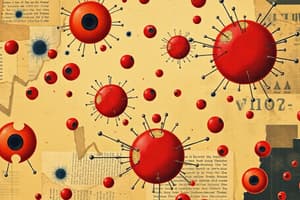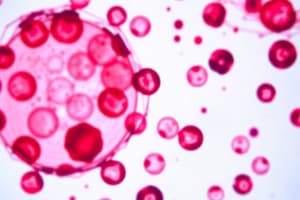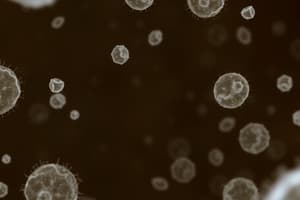Podcast
Questions and Answers
Which type of white blood cell is most prevalent in the blood of adults?
Which type of white blood cell is most prevalent in the blood of adults?
- Eosinophils
- Lymphocytes
- Basophils
- Neutrophils (correct)
What is the role of monocytes in the immune system?
What is the role of monocytes in the immune system?
- To produce antibodies
- To directly attack and kill pathogens
- To mature into macrophages in tissues (correct)
- To initiate the inflammatory response
What characteristic distinguishes band neutrophils from segmented neutrophils?
What characteristic distinguishes band neutrophils from segmented neutrophils?
- They are more prominent in chronic infections
- They have a completely segmented nucleus
- They have a nucleus with more than ½ indentation (correct)
- They are the primary response cells in allergic reactions
In a differential count of white blood cells, which is likely to be higher in infants compared to adults?
In a differential count of white blood cells, which is likely to be higher in infants compared to adults?
Which statement is true regarding neutrophils?
Which statement is true regarding neutrophils?
What is the main fate of stem cells before they become committed?
What is the main fate of stem cells before they become committed?
What happens to stem cells that remain uncommitted for an extended period?
What happens to stem cells that remain uncommitted for an extended period?
What does the Rule of Three involve in the context of blood test results?
What does the Rule of Three involve in the context of blood test results?
Which progenitor cell type is primarily responsible for producing blood cells excluding lymphocytes?
Which progenitor cell type is primarily responsible for producing blood cells excluding lymphocytes?
During which developmental stage does the liver take over hematopoietic activity?
During which developmental stage does the liver take over hematopoietic activity?
Which red blood cell characteristics are assessed to identify anomalies?
Which red blood cell characteristics are assessed to identify anomalies?
What does MCV represent in a complete blood count?
What does MCV represent in a complete blood count?
What is true about embryonic hemoglobin produced by primitive erythroblasts?
What is true about embryonic hemoglobin produced by primitive erythroblasts?
What characterizes common lymphoid progenitor cells?
What characterizes common lymphoid progenitor cells?
Which factor is crucial to perform before evaluating red blood cell abnormalities?
Which factor is crucial to perform before evaluating red blood cell abnormalities?
What is indicated by normocytic and normochromic red blood cells?
What is indicated by normocytic and normochromic red blood cells?
Which statement correctly describes the difference in impact between myeloid leukemia and lymphoid leukemia?
Which statement correctly describes the difference in impact between myeloid leukemia and lymphoid leukemia?
What is the initial role of the yolk sac in fetal development regarding blood cells?
What is the initial role of the yolk sac in fetal development regarding blood cells?
What is the significance of basophilia in immature blood cells?
What is the significance of basophilia in immature blood cells?
Which staining method is used to identify polychromatophilic erythrocytes?
Which staining method is used to identify polychromatophilic erythrocytes?
What happens to pronormoblasts during their lifecycle?
What happens to pronormoblasts during their lifecycle?
What characterizes the staining of mature erythrocytes?
What characterizes the staining of mature erythrocytes?
What ultimately leads to an erythrocyte losing its nucleus?
What ultimately leads to an erythrocyte losing its nucleus?
In relation to cell staining, what makes a cell appear eosinophilic?
In relation to cell staining, what makes a cell appear eosinophilic?
Why does the cytoplasm of immature blood cells initially stain light?
Why does the cytoplasm of immature blood cells initially stain light?
What is the role of basic stains in cell staining characteristics?
What is the role of basic stains in cell staining characteristics?
What should be avoided to ensure the complete separation of RBCs from plasma/serum?
What should be avoided to ensure the complete separation of RBCs from plasma/serum?
What effect can leukocytosis have during blood tests?
What effect can leukocytosis have during blood tests?
What happens if the RBCs are resuspended when not immediately read?
What happens if the RBCs are resuspended when not immediately read?
Why is it important to position the reader at the edge of the RBCs with plasma?
Why is it important to position the reader at the edge of the RBCs with plasma?
What could be a consequence of squeezing the puncture site excessively?
What could be a consequence of squeezing the puncture site excessively?
Which condition can lead to falsely elevated hematocrit readings?
Which condition can lead to falsely elevated hematocrit readings?
What is the primary purpose of Drabkin’s reagent in blood testing?
What is the primary purpose of Drabkin’s reagent in blood testing?
What is a recognized source of error when measuring hematocrit levels?
What is a recognized source of error when measuring hematocrit levels?
Flashcards are hidden until you start studying
Study Notes
WBC Differential Count
- Lymphocytes are the most numerous WBC in infants/children, followed by neutrophils.
- In adults, neutrophils are the most abundant, followed by lymphocytes, monocytes, eosinophils, and finally basophils.
- Neutrophils have a segmented nucleus in peripheral blood.
- Elevated neutrophils indicate acute bacterial infection (early phase).
- Band neutrophils have a less segmented nucleus, with indentations more than half the diameter.
Hematopoiesis
- Stem cells originate from the mesoblast (yolk sac) and give rise to various blood cells.
- Primitive erythroblasts are produced in the yolk sac during fetal development.
- Hepatic hematopoiesis takes place in the liver after a few months, replacing the yolk sac function.
- Medullary/bone marrow hematopoiesis occurs towards the end of pregnancy and continues into adulthood.
Stem Cell Fates
- Self-renewal: Stem cells can repopulate themselves until they become committed to a specific lineage.
- Differentiation: Committed stem cells undergo differentiation to produce specific blood cell types.
- Apoptosis: Uncommitted stem cells can undergo programmed cell death to prevent overpopulation in the bone marrow.
Progenitor Cells
- Common myeloid progenitor cell: Produces all blood cells except lymphocytes.
- Common lymphoid progenitor cell: Produces lymphocytes.
- Myeloid leukemia affects multiple cell lines, making it more severe.
- Lymphoid leukemia affects a single cell line, making it less severe.
Red Blood Cell Development
- Primitive erythroblasts carry embryonic hemoglobin (Gower 1, Gower 2, and Portland hemoglobin).
- Embryonic hemoglobins have different globin chains compared to adult hemoglobin.
- Mature red blood cells lack a nucleus.
Erythroblast Stages
- Pronormoblast/Rubriblast: The youngest erythroblast, characterized by a loose chromatin and basophilic cytoplasm.
- Basophilic Normoblast/Prorubricyte: Shows intense staining due to condensed chromatin and high ribosome/RNA content in the cytoplasm.
- Erythrocytes remain in circulation for 1-3 days before being "polished" into mature erythrocytes.
Polychromatophilic Erythrocytes and Reticulocytes
- Polychromatophilic erythrocytes are identified using Wright's stain (Romanowsky stain).
- Reticulocytes are identified using supravital stains like New Methylene blue (NMB) or Brilliant Crescent Blue (BCB).
- Both cell types exhibit basophilia due to their high content of ribosomes and RNA.
Sources of Errors in Red Blood Cell Count
- Exposure of reagents to light
- Leukocytosis
- Lipemia
- Hemolysis-resistant RBCs
- Abnormal globulins
- Carboxyhemoglobin
- Improper resuspension of RBCs
- Incorrect use of reading equipment
- Hemoglobinopathies
- Excessive pressure on the puncture site
Hemoglobin Measurement
- Cyanmethemoglobin is a stable compound formed by oxidation and transfer of cyanide molecules to hemoglobin and is measured spectrophotometrically.
- Drabkin's reagent is a lysing agent used to release hemoglobin molecules from RBCs; typically stored in amber bottles due to photosensitivity.
Mean Cell Volume (MCV), Mean Cell Hemoglobin (MCH), and Mean Cell Hemoglobin Concentration (MCHC)
- MCV is used to estimate red blood cell size and is expressed in fentoliters (fL).
- MCHC is often used by physicians to identify different types of anemia.
- MCH is equally valuable as MCV and MCHC in identifying different forms of anemia.
- The "rule of three" can be used to assess red blood cell size and hemoglobin content. It is recommended to review blood smear results if parameters fall outside the "rule of three" to confirm normocytic and normochromic characteristics.
Studying That Suits You
Use AI to generate personalized quizzes and flashcards to suit your learning preferences.




